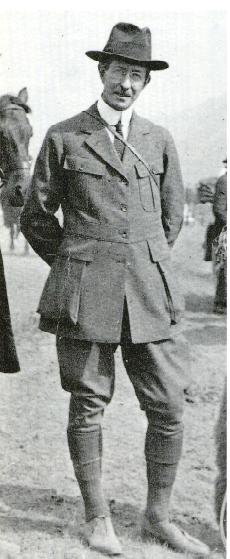
Photo: Walter Wilcox (courtesy Whyte Archives)
Walter D. Wilcox
(1869-1949) An American student from Yale University, Walter Wilcox was one of the first to visit Lake Louise, spending much of the summer of 1893 camped on its shore. Wilcox had met Samuel Allen< in Banff and the two completed the first ascent of Fairview Mountain. The pair also attempted Mount Temple and explored the slopes of Mount Victoria. In 1894 Wilcox, Samuel Allen, and three others paid $12 per week for accommodation, meals, and the use of horses and a boat at the first chalet at Lake Louise. Allen and Wilcox had visited the area before and had failed in attempts to climb Mount Victoria and Mount Temple. But they had big plans for the summer of 1894 and returned with a better equipped expedition which included other students from Yale. They referred to themselves as the Lake Louise Club and were bent on exploring, climbing and mapping in what was then uncharted wilderness. Although inexperienced in the techniques of mountaineering, the group set out to climb Mount Lefroy. A large boulder was dislodged, striking Louis Frissell and seriously injuring him. A doctor travelled from Banff by handcar on the railway and the young man recovered in hospital. Following this near disaster, the "club" focused on lower altitude explorations discovering Paradise Valley and Wenkchemna Valley (The Valley of the Ten Peaks). They also completed first ascents of two easier peaks, Mount Aberdeen and Mount Temple where, "Many a hearty cheer rent the thin air as our little party of three reached the summit, for we were standing where no man had ever stood before, and...at the highest altitude yet reached in North America north of the United States boundary." Despite the successful ascent of Mount Temple, the group's inexperience in climbing had been demonstrated on Mount Lefroy and through the summer their limitations regarding glacier travel and cooking (one of the group recalled forty years later that he, "still remembered that stomach ache") led to other near disasters. But they persevered and when the club's members returned to their homes in the eastern United States, they had explored over one hundred square kilometres of country around Lake Louise. As well, the group chose the names of many of the lakes and mountains in the area, made a detailed map, and measured the depth of Lake Louise. A major contribution was "Camping in the Canadian Rockies," which was written by Walter Wilcox. The first major book about the Rockies, it was to inspire many others to explore and climb in the Canadian Rockies. "No scene has ever given me an equal impression of inspiring solitude and rugged grandeur." This was Walter Wilcox's reaction when he became one of the first visitors to the Valley of the Ten Peaks. In 1894 his companion, Samuel Allen, had chosen to name the peaks from east to west using the numbers from the Stoney Indian language as follows: Heejee, Nom, Yamnee, Tonsa, Sapta, Shappee, Sagowa, Saknowa, Neptuak, and Wenkchemna. A number of Stoney Indians had been hired to look after the horses used by Wilcox and his group and Allen must have learned the numbers from them. All but two of the peaks have subsequently been renamed to honour a variety of individuals. In 1895 Wilcox made the first complete circuit of Mount Assiniboine. In 1896 Walter Wilcox, Robert L. Barrett and guides Tom Lusk and Fred Stephens travelled north over Bow Pass, up the Saskatchewan River and became the first to reach Sunwapta Pass. They were on a sixty day expedition and searching for a pass through which to reach the Athabasca River. Impressed by, “the tremendous grandeur of mountain scenery,” the group explored the area, Barrett even attempting to climb, “a beautiful, glacier-hung peak” which must have been Mount Athabasca. In order to determine if the party could continue over the newly discovered pass, Fred Stephens was able to pass between the toe of the Athabasca Glacier and the steep slopes of Mount Wilcox but found that, “the route which first appeared most promising was blocked by a canyon.” The party then proceeded over a high grassy pass to the east of what is now known as Mount Wilcox, descending into the Sunwapta Valley beyond Tangle Falls and the steep canyon to continue their explorations. The pass was later named in honour of Walter Wilcox. In 1901, Walter Wilcox, accompanied by Tom Lusk, Henry Bryant, James Wood, and Ben Woodworth, spent much of the month of August exploring the Upper Kananaskis Valley including visits to North Kananaskis Pass and Aster Lake. During their visit, Wilcox made the first ascent of what is now Mount Indefatigable. During 1940, Wilcox made his last visit to the Canadian Rockies at the age of 71. J.W.A. Hickson wrote that, "He was as enthusiastic over the trees and scenery of the mountains a he had been forty years before." [Additional Information: Wilcox, Walter D. "Camping in the Canadian Rockies". New York: G.P. Putnam's Sons, 1897]